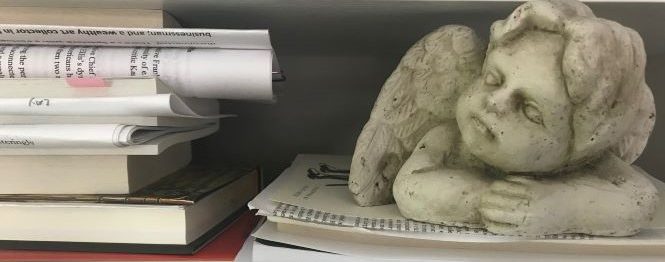I once produced a radio segment about Paul Laurence Dunbar, and from that I never forgot the famous 20th century poet who graduated with honors from Dayton, Ohio’s public schools in 1891. After graduation, Dunbar became an elevator operator in a Dayton office building, working 11-hour days and earning four dollars a week. “Still chained to the ropes of my dingy elevator,” he wrote in a letter. He published his first volume of poetry, Oak and Ivy, in 1893.

Born during Reconstruction to once enslaved parents, Paul Laurence Dunbar “excelled against all odds” to become not only a famous poet (how most know him today) but also a novelist, essayist, playwright, and Broadway librettist. He was quite popular, and yet he “privately bemoaned shouldering the burden of race and catering to minstrel stereotypes to earn fame and money.” That information and quote comes from the summary of Paul Laurence Dunbar: The Life and Times of a Caged Bird, a recently published biography I purchased for myself, the one you see here, with Dunbar looking out at us from the dustjacket. The summary also says Dunbar was one of the first African American writers to garner international recognition in the wake of emancipation. Poet Maya Angelou borrowed the first line of Dunbar’s poem “Sympathy” for the title of her famous autobiography, I Know Why the Caged Bird Sings.
FYI: Princeton University Press includes the Dunbar biography in their current Book Lovers Sale at 75% off, so instead of $35 Paul Laurence Dunbar: The Life and Times of a Caged Bird by Gene Andrew Jarrett is $8.95, not including shipping. Last I checked, the sale ends February 21.

This is a heads-up that American poet, essayist, and cultural critic Hanif Abdurraqib is publishing a new book in March. This dynamic, compassionate, and well-loved author lives right here in Columbus, Ohio, a graduate of Beechcroft High School. There’s Always This Year: On Basketball and Ascension is described on my advanced reading copy as a poignant, personal reflection on basketball, life, and Lebron James. The publisher makes a big claim based on Mr. Abdurraqib’s previous works and, indeed, his unique voice, saying: “[the book’s] true power comes from the once in a generation writing talent behind it.” There’s Always This Year more than likely will become a huge success. From a description inside the ARC:
Growing up in Columbus in the 1990s, Abdurraqib witnessed a golden era of basketball, one in which legends like LeBron were forged and countless others weren’t. His lifelong love of the game leads Abdurraqib into a lyrical, historical, and emotionally rich exploration of what it means to make it, who we think deserves success, the tension between excellence and expectation, and the very notion of role models, all of which he expertly weaves together with memoir.

Finally, a posthumously published collection of short stories about Black Americans living through the everyday perils of Jim Crow racism in the 1950s and ’60s. What’s striking about the stories I’ve read so far in Diane Oliver’s Neighbors is their clarity and precision in easy prose and then the fear and wrong and hurt we feel reading them. For example, in the first story, a family suffers anxiousness and doubt over the decision to send their son to an all-white school to participate in integration. He’ll be the only Black child in the classroom. “I keep wondering if we should send him,” the father says. “There’s no telling what these fool white folks will do.” In the next story, a family sends their daughter to a private Southern girls’ college. “As her father had warned her, everyone pretended she wasn’t there.”
Author Diane Oliver published four of the short stories in this collection before she tragically died in a motorcycle accident at age 22 in 1966. Three more stories were published after her death. She was working toward a Master of Fine Arts degree at the University of Iowa’s Writers’ Workshop.
